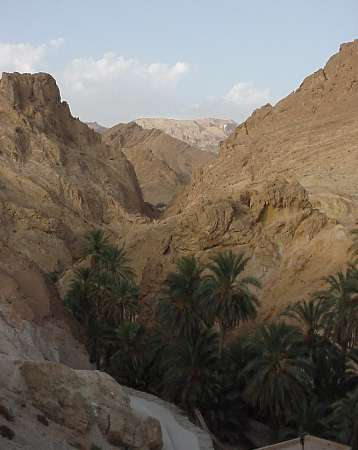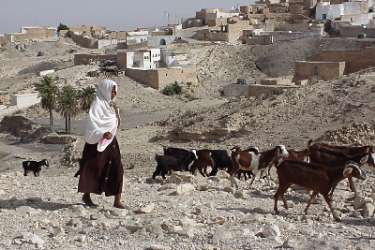 |
 |
 |
Visitors to Tunisia have the opportunity to see the beautiful interior of the country by taking advantage of one of the many tours available. Our excursion was in a four-by-four all-terrain vehicle in a guided group of about twenty-five tourists.
Our three-day trip left from Sousse and traveled through the Djerid, Nefzaoua, and Matmata areas of the country. We drove through mountains and salt flats, passed miles of olive and date groves, walked on powdery sand dunes, and saw livestock, mules and camels casually walking around the villages and farmlands. Children in their navy blue school vests would smile and wave to us enthusiastically and were thrilled when we waved back to them, as if dozens of four-by-fours didn't come through town every day.
We took a calèche (buggy) ride through the Corbeille oasis and drank laghmi, a sweet wine of fermented palm tree sap, drank mint tea in fluted glasses, and ate pomegranates and dates right from the tree. In a visit to a troglodyte house, we saw the people whose ancestors have lived in these underground dwellings for 700 years (familiar to anyone who has seen Star Wars.)
|
Getting onto a camel is a three-step process. You mount the camel when he is in a kneeling position. It is important to hold tight to the harness as the camel lifts with a jolt, first from the front, then the back, then again at the front. |
|
|
Three kinds of oasis – the desert oasis, mountain oasis, and maritime oasis – appear in Tunisia's countryside. An oasis occurs when there is water below the surface of the dry terrain, and often the palm trees that indicate the oasis extend for quite a distance. Because the oasis represents a water source, these are often the places where villages have developed in the desert. |
 |
 |
In the village of Tamezret, this woman was tending her flock by walking alongside, or sitting and making hissing noises, or tossing small stones to keep them from wandering too far away. Tamezret is one of the few places where the language of the indigenous Berber people is still in use, due to the relative isolation of this hillside village. |
|
|
|
|
|
|
|
El Djem is now a town of about 10,000, but its ancient predecessor was three times that size. This Roman amphitheatre is the largest Roman monument in all of North Africa and the third largest amphitheatre in the Roman Empire. Construction is thought to have begun in the third century AD in the reign of Emperor Gordien I. The building was never completed, but it was used for the spectacles of the time: wild beasts fighting each other to the death, gladiator exhibitions, or martyrs or prisoners thrown to wild animals. |
|